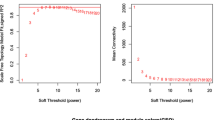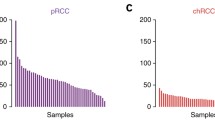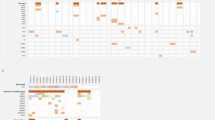Abstract
The tumor suppressor LKB1 gene is a master kinase and inhibits mammalian target of rapamycin (mTOR) by activating AMP-activated protein kinase (AMPK) and AMPK-related kinases. LKB1 is a critical intermediate in the mTOR signaling pathway, and mutations of the LKB1 gene have been implicated in the development of different tumor types. Recent evidence indicates that LKB1 alterations contribute to cancer progression and metastasis by modulating vascular endothelial growth factor (VEGF) production. The Ras homolog enriched in brain (RHEB) protein is a component of the mTOR pathway and functions as a positive regulator of mTOR. However, the mechanisms and effectors of RHEB in mTOR signaling are not well known. In this study, we analyzed the expression of RHEB and HIF1α genes in correlation with LKB1 gene mutations. All coding exons and exon/intron boundaries of the LKB1 gene were analyzed by direct sequencing in 77 renal cell carcinoma (RCC) tumors and 62 matched noncancerous tissue samples. In 51.6 % of the patients, ten different mutations including four novel mutations in the coding sequences and six single nucleotide substitutions in the introns were observed. Rheb and HIF1α expression levels were not statistically different between the tumor and corresponding noncancerous tissue samples. However, expression of the Rheb gene was upregulated in the tumor samples carrying the intron 2 (+24 G→T) alteration. Association between the gene expression and tissue protein levels was also analyzed for HIF1α in a subgroup of patients, and a high correlation was confirmed. Our results indicate that the LKB1 gene is frequently altered in RCC and may play a role in RCC progression.

Similar content being viewed by others
References
Cho E, Lindblad P, Adami HO. Kidney cancer. In: Adami HO, Hunter D, Trichopoulos D, editors. Textbook of cancer epidemiology. 2nd ed. New York: Oxford University Press; 2008.
Elfiky AA, Aziz SA, Conrad PJ, Siddiqu S, Hackl W, Maira M, et al. Characterization and targeting of phosphatidylinositol-3 kinase (PI3K) and mammalian target of rapamycin (mTOR) in renal cell cancer. J Trans Med. 2011;9:133.
The Cancer Genome Atlas Research Network. Comprehensive molecular characterization of clear cell renal cell carcinoma. Nature. 2013;499:43–9.
Sato Y, Yoshizato T, Shiraishi Y, Maekawa S, Okuno Y, Kamura T, et al. Integrated molecular analysis of clear cell renal cell carcinoma. Nat Genet. 2013;45:860–7.
Hara K, Maruki Y, Long X, Yashino K, Oshiro N, Hidayat S, et al. Raptor, a binding partner of target of rapamycin (TOR), mediates TOR action. Cell. 2002;110:177–89.
Garami A, Zwartkruis FJ, Nobukuni T, Joaquin M, Roccio M, Stocker H, et al. Insulin activation of Rheb, a mediator of mTOR/S6K/4E-BP signaling, is inhibited by TSC1 and 2. Mol Cell. 2003;11:1457–66.
Shaw RJ, Bardeesy N, Manning BD, Lopez L, Kosmatka M, De Pinho RA, et al. The LKB1 tumor suppressor negatively regulates mTOR signaling. Cancer Cell. 2004;6:91–9.
Li Y, Corradetti MN, Inoki K, Guan KL. TSC2: filling the GAP in the mTOR signaling pathway. Trends Biochem Sci. 2004;29:32–8.
Saucedo LJ, Gao X, Chiarelli DA, Li L, Pan D, Edgar BA. Rheb promotes cell growth as a component of the insulin/TOR signalling network. Nat Cell Biol. 2003;5:566–71.
Katajisto P, Vallenius T, Vaahtomeri K, Ekman N, Udd L, Tiainen M, et al. The LKB1 tumor suppressor kinase in human disease. Biochim Biophys Acta. 2007;1775:63–75.
Lizcano JM, Göransson O, Toth R, Deak M, Morrice NA, Boudeau J, et al. LKB1 is a master kinase that activates 13 kinases of the AMPK subfamily, including MARK/PAR-1. EMBO J. 2004;23:833–43.
Corradetti MN, Inoki K, Bardeesy N, De Pinho RA, Guan KL. Regulation of the TSC pathway by LKB1: evidence of a molecular link between tuberous sclerosis complex and Peutz-Jeghers syndrome. Genes Dev. 2004;18:1533–8.
Ylikorkala A, Rossi DJ, Korsisaari N, Luukko K, Alitalo K, Henkemeyer M, et al. Vascular abnormalities and deregulation of VEGF in Lkb1-deficient mice. Science. 2001;293:1323–6.
Harris AL. Hypoxia—a key regulatory factor in tumour growth. Nat Rev Cancer. 2002;2:38–47.
Baldewijns MM, van Vlodrop IJ, Vermeulen PB, Soetekouw PM, vn Engeland M, de Bruiine AD, et al. VHL and HIF signalling in renal cell carcinogenesis. J Pathol. 2010;221:125–38.
Robb VA, Karbowniczek M, Klein-Szanto AJ, Henske EP. Activation of the mTOR signaling pathway in renal clear cell carcinoma. J Urol. 2007;177:346–52.
Voss MH, Hakimi AA, Pham CG, Brannon AR, Chen YB, Cunha LF, et al. Tumor genetic analyses of patients with metastatic renal cell carcinoma and extended benefit from mTOR inhibitor therapy. Clin Cancer Res. 2014;20:1955–64.
Chism DD, Rathmell K. Seeing the forest fort he trees: kidney oncogenomes in relation to therapeutic outcomes. Clin Cancer Res. 2014;20:1721–3.
Tigli H, Seven D, Tunc M, Sanli O, Basaran S, Ulutin T, et al. LKB1 mutations and their correlation with LKB1 and Rheb expression in bladder cancer. Mol Carcinog. 2013;52:660–5.
Onozato R, Kosaka T, Achiwa H, Kuwano H, Takahashi T, Yatabe Y, et al. LKB1 gene mutations in Japanese lung cancer patients. Cancer Sci. 2007;98:1747–51.
Kenanli E, Karaman E, Enver O, Ulutin T, Buyru N. Genetic alterations of the LKB1 gene in head and neck cancer. DNA Cell Biol. 2010;29:735–8.
Avizienyte E, Roth S, Loukola A, Hemminki A, Lothe RA, Stenwig AE, et al. Somatic mutations in LKB1 are rare in sporadic colorectal and testicular tumors. Cancer Res. 1998;58:2087–90.
Avizienyte E, Loukola A, Roth S, Hemminki A, Tarkanken M, Salovaara R, et al. LKB1 somatic mutations in sporadic tumors. Am J Pathol. 1999;154:677–81.
Sakamoto K, McCarthy A, Smith D, Gren KA, Garahame Hardie D, Ashworth A, et al. Deficiency of LKB1 in skeletal muscle prevents AMPK activation and glucose uptake during contraction. EMBO J. 2005;24:1810–20.
Granot Z, Swisa A, Magenheim J, Stolovich-Rein M, Fujimoto W, Manduchi E, et al. LKB1 regulates pancreatic beta cell size, polarity, and function. Cell Metab. 2009;10:296–308.
Duivenvoorden WC, Beatty LK, Lhotak S, Hill B, Mak I, Paulin G, et al. Underexpression of tumor suppressor LKB1 in clear cell renal carcinoma is common and confers growth advantage in vitro and in vivo. Br J Cancer. 2013;108:327–33.
Lim W, Olschwang S, Keller JJ, Westerman AM, Menko FH, Bardman LA, et al. Relative frequency and morphology of cancers in STK11 mutation carriers. Gastroenterology. 2004;126:1788–94.
Kline ER, Muller S, Pan L, Tighiouart M, Chen ZG, Marcus AI. Localization-specific LKB1 loss in head and neck squamous cell carcinoma metastasis. Head Neck. 2011;33:1501–12.
Launonen V. Mutations in the human LKB1/STK11 gene. Hum Mutat. 2005;26:291–7.
Alessi DR, Sakamoto K, Bayascas JR. LKB1-dependent signaling pathways. Annu Rev Biochem. 2006;75:137–63.
Hawley SA, Boudeau J, Reid JL, Mustard KJ, Udd L, Makela TP, et al. Complexes between the LKB1 tumor suppressor, STRAD alpha/beta and MO25 alpha/beta are upstream kinases in the AMP-activated protein kinase cascade. J Biol. 2003;2:28.
Dong SM, Kim KM, Kim SY, Shin MS, Na EY, Lee SH, et al. Frequent somatic mutations in serine/threonine kinase 11/Peutz-Jeghers syndrome gene in left-sided colon cancer. Cancer Res. 1998;58:3787–90.
Boudeau J, Baas AF, Deak M, Morrice NA, Kieloch A, Schulkowski M, et al. MO25alpha/beta interact with STRADalpha/beta enhancing their ability to bind, activate and localize LKB1 in the cytoplasm. EMBO J. 2003;22:5102–14.
Gerlinger M, Rowan AJ, Horswell S, Larkin J, Endesfelder D, Gronroos E, et al. Intratumor heterogeneity and branched evolution revealed by multiregion sequencing. N Engl J Med. 2012;366:883–92.
Qui W, Schönleben F, Thaker HM, Goggins M, Su GH. A novel mutation of STK11/LKB1 gene leads to the loss of cell growth inhibition in head and neck squamous cell carcinoma. Oncogene. 2006;25:2937–42.
Land SC, Tee AR. Hypoxia-inducible factor 1alpha is regulated by the mammalian target of rapamycin (mTOR) via an mTOR signaling motif. J Biol Chem. 2007;282:20534–43.
Gromov PS, Madsen P, Tomerup N, Celis JE. A novel approach for expression cloning of small GTPases: identification, tissue distribution and chromosome mapping of the human homolog of Rheb. FEBS Lett. 1995;377:221–6.
Bernardi R, Guernah I, Jin D, Grisendi S, Alimonti A, Teruya-Feldstein J, et al. PML inhibits HIF-1alpha translation and neoangiogenesis through repression of mTOR. Nature. 2006;442:779–85.
Wiesener MS, Münchenhagen PM, Berger I, Morgan NV, Roigas J, Schwiertz A, et al. Constitutive activation of hypoxia-inducible genes related to overexpression of hypoxia-inducible factor-1alpha in clear cell renal carcinomas. Cancer Res. 2001;61:5215–22.
Turner KJ, Moore JW, Jones A, Taylor CF, Cuthbert-Heavens D, Hen C, et al. Expression of hypoxia-inducible factors in human renal cancer: relationship to angiogenesis and to the von Hippel-Lindau gene mutation. Cancer Res. 2002;62:2957–61.
Acknowledgments
The present work was supported by the Research Fund of Istanbul University, Project No. T-845/0206200.
Author information
Authors and Affiliations
Corresponding author
Rights and permissions
About this article
Cite this article
Yalniz, Z., Tigli, H., Tigli, H. et al. Novel mutations and role of the LKB1 gene as a tumor suppressor in renal cell carcinoma. Tumor Biol. 35, 12361–12368 (2014). https://doi.org/10.1007/s13277-014-2550-4
Received:
Accepted:
Published:
Issue Date:
DOI: https://doi.org/10.1007/s13277-014-2550-4




